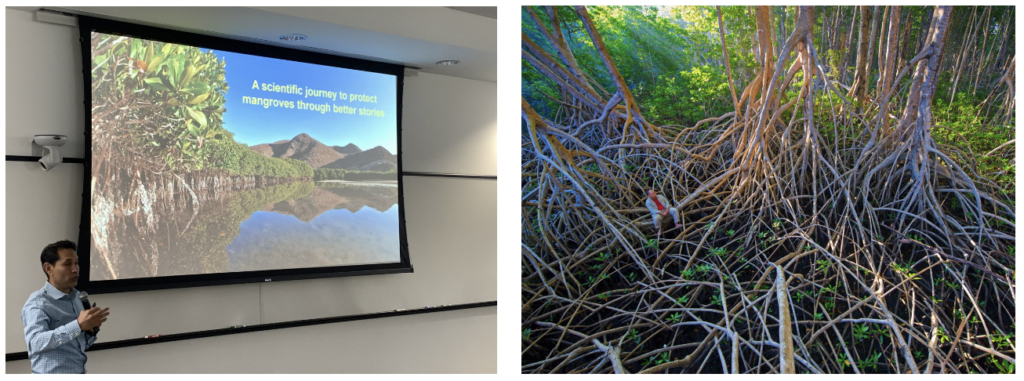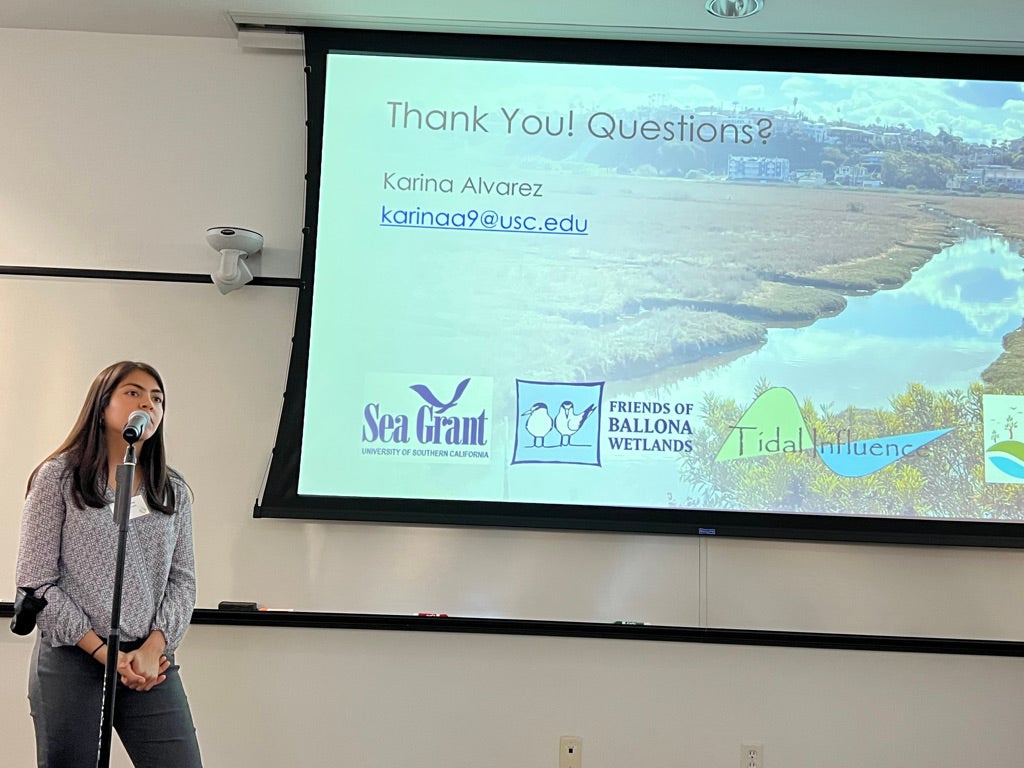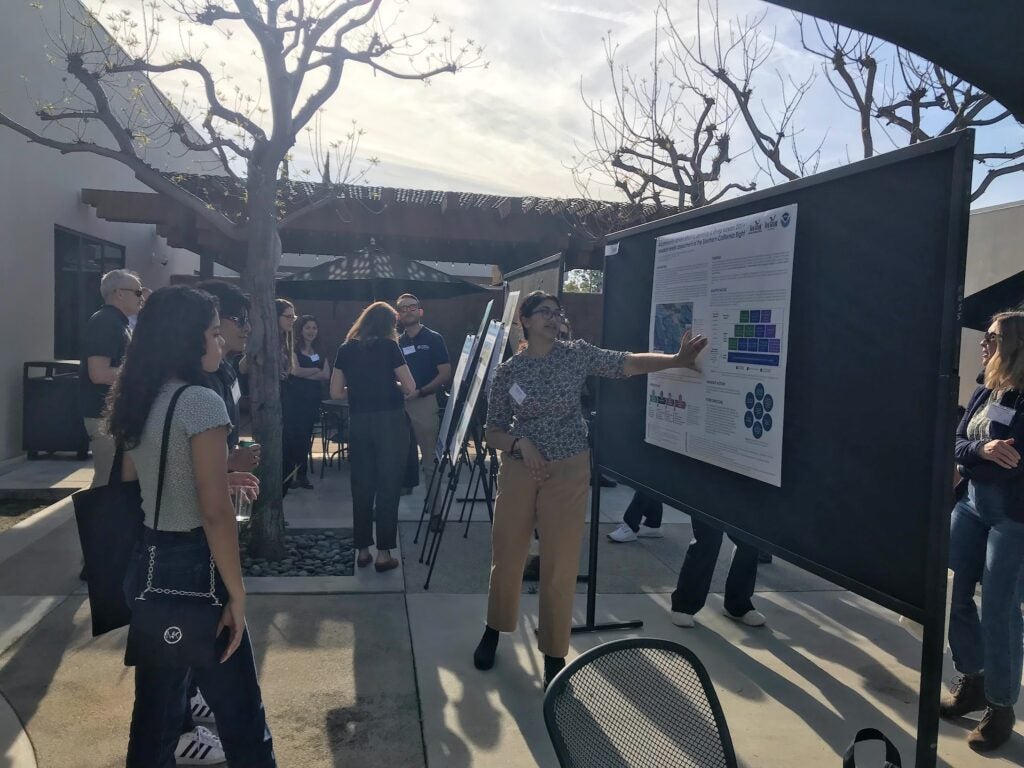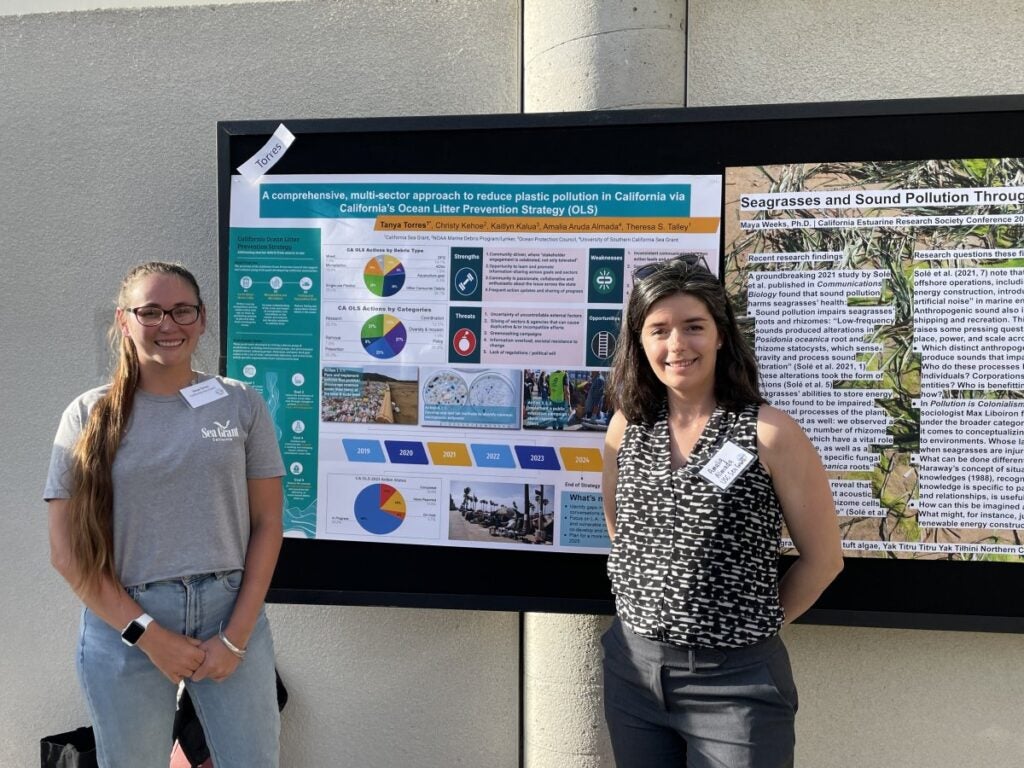
USC Sea Grant Representation at 2023 CAERS Meeting
The 2023 California Estuarine Research Society (CAERS) Conference occurred in Costa Mesa, CA from April 21-22, 2023. USC Sea Grant was a proud sponsor and participant in the event, including supporting the attendance of four students from undergraduate and graduate schools across Northern and Southern California and supporting the plenary speaker, Dr. Octavio Aburto.
CAERS is a non-profit organization dedicated to the improvement of education and research regarding California’s and Baja California’s estuarine and coastal environments. The 2023 Conference spanned two days and included presentations and discussions about the estuaries and coasts of California and Baja California, Mexico. USC Sea Grant participated in the event’s presentations and poster sessions, sharing multiple projects our program is involved in to improve Southern California’s coastal and estuarine environments. Below is a summary of the USC Sea Grant-supported sessions and projects presented at the event.
Supporting the Plenary Speaker
USC Sea Grant was proud to sponsor the plenary speaker, Octavio Aburto, who presented on “A scientific journey to protect mangroves through better stories”. Dr. Aburto is a marine biology professor at the University of California, San Diego, as well as an avid photographer taking captivating photos in an effort to use science to influence conservation.

USC Sea Grant Representation in Presentation Sessions
Restoration Efforts in the Ballona Wetlands:
Karina Alvarez, USCSG Coastal Extension Specialist, presented our work supporting restoration efforts in the Ballona Wetlands during an afternoon session titled “How do we monitor and understand the factors determining community composition in coastal ecosystems?”
- Presentation Title: Monitoring vegetation invasion and habitat conversion in the Ballona Wetlands to inform restoration activities
- Project Partners: Neysa Frechette (Friends of Ballona Wetlands), Karina Alvarez (USC Sea Grant), Karina Johnston (Univ. of California, Santa Barbara), Amanda McCarthy(Eco Eleemosynary), Ivan Mendel (Integral Ecology Research Center)
- Presentation Abstract: The Ballona Wetlands Ecological Reserve (BWER), at just under 600 acres, represents the largest opportunity for wetland restoration in Los Angeles County. Despite a long history of severe anthropogenic impacts, BWER includes a variety of habitats that provide multiple ecosystem services for this heavily urbanized region. Sitewide vegetation mapping surveys were conducted in 2007, 2013, and 2021 to assess changes in vegetation and habitat types over time. Survey results indicate an overall increase in non-native tall herbaceous habitat (70-acre increase since 2007), largely attributed to non-native species such as Brassica nigra and Euphorbia terracina, and an overall increase in non-native vegetation cover, especially in areas with the largest historic fill impacts. This habitat type accounted for the loss of several habitat types, including annual/ruderal grassland, ruderal marsh, and upland scrub. Loss of non-tidal salt marsh (30-acre decrease since 2007), often to ruderal marsh, represented the largest decline of all native wetland habitat types. A notable exception to these trends, however, was in areas with restoration activities, which experienced overall increases in native vegetation cover. These trends indicate an imminent need for restoration. Results will inform restoration activities at the site going forward.

USC Sea Grant Representation in Poster Sessions
Deep Ocean DDT+ Research Needs Assessment:
Amulya Jasti, USC Sea Grant intern (Wrigley Zinsmeyer Summer Research Intern), alongside Amalia Almada, USCSG Science, Research, and Policy Specialist, presented on USC Sea Grant’s recent joint project with California Sea Grant on developing a deep ocean DDT+ research needs assessment of Southern California.
- Poster Title: A community-driven effort to develop a deep ocean DDT+ research needs assessment of Southern California
- Project Partners: Amulya Jasti and Amalia Almada (USC Sea Grant), Lian Guo (California Sea Grant), Charlotte Stevenson and Leah Shore (USC Sea Grant)
- Poster Abstract: DDT (Dichlorodiphenyltrichloroethane) may be an old pollutant, but recent scientific findings and media focus have reignited concern about a broad suite of DDT breakdown products and related byproducts (referred to as “DDT+”) in the deep ocean of the Southern California Bight (SCB). In January 2023, the USC and California Sea Grant Programs released a new report – A Deep Ocean DDT+ Research Needs Assessment of the Southern California Bight – that details what research is needed most urgently to understand the extent and potential implications of the deep ocean DDT on ecosystem and human health in the SCB. Sea Grant facilitated inclusive discussions between the academic community and various local, regional, and state entities to identify diverse perspectives on DDT+ research needs, including through community listening sessions, a deep literature review, and hosting a workshop in July 2022. The Assessment outlines an extensive list of research needs, proposes an adaptive model of how research areas relate and build on one another, and provides a synthesis of those immediate actions necessary to effectively mobilize deep ocean DDT+ research. Despite Southern California’s complicated history with DDT+, this Assessment highlights the opportunity for spearheading a new chapter driven by exceptionally collaborative, innovative, and efficient deep ocean DDT+ research.

Reducing plastic pollution in California via California’s Ocean Litter Prevention Strategy:
Amalia Almada, USCSG Science, Research, and Policy Specialist, presented alongside Tanya Torres (California Sea Grant) on a joint project developing and implementing the California Ocean Litter Prevention Strategy.
- Poster Title: A comprehensive, multi-sector approach to reduce plastic pollution in California via California’s Ocean Litter Prevention Strategy
- Project Partners: Tanya Torres (California Sea Grant), Christy Kehoe (NOAA Marine Debris Program), Kaitlyn Kalua (California Ocean Protection Council), Amalia Aruda Almada (USC Sea Grant), Theresa Talley (California Sea Grant).
- Poster Abstract: Most of the pollution in the world’s oceans is land-based trash, traveling from upstream, often urban, environments through storm drains and waterways into coastal and ocean environments, degrading ecosystems and water quality, and triggering significant economic and health costs. California has become a global leader in addressing this problem through ambitious environmental policies and innovative solutions such as the California Ocean Litter Prevention Strategy (OLS), a collaborative, multi-sector approach to managing and preventing marine debris and its harmful effects. The OLS was initiated in 2008 by the California Ocean Protection Council and NOAA’s Marine Debris Program, and revised in 2018 with the help of California Sea Grant. Since then, the OLS has made significant progress by bringing together diverse stakeholders who lead specific actions across six goals: source reduction; changes in product design; waste management and land-based interventions; research; behavior change and education; and ocean-based debris prevention and clean-up. Localized efforts include a public education campaign about cigarette filters and the removal of over 9,000 lbs of debris from a marine sanctuary. Next phases of implementation include strengthening the diversity, inclusion, accessibility, equitability, and justice of the OLS, with a focus on urban watersheds in Los Angeles County.
